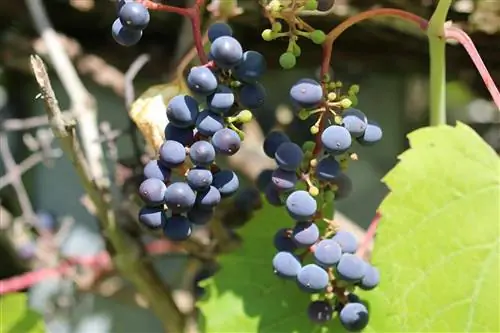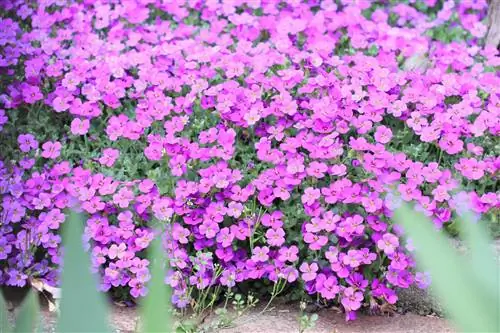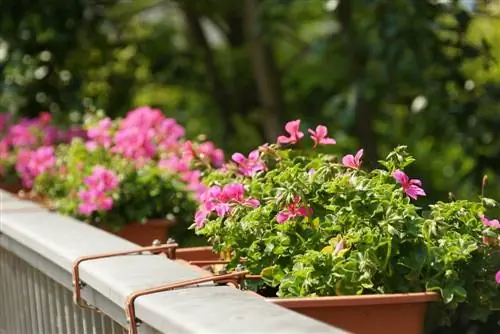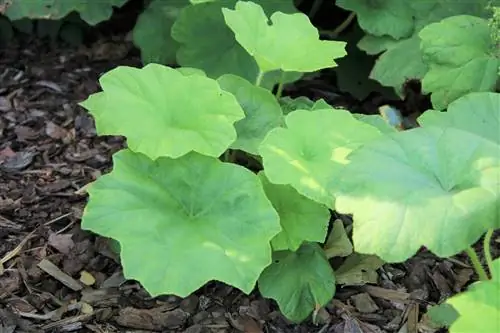- Author admin [email protected].
- Public 2023-12-17 03:39.
- Last modified 2025-01-24 12:45.
Grapes, whether climbing plants, espaliers or vines, enrich every garden. In addition to the tasty grapes, the climbing plants add greenery to house walls and gazebos. Growing old, respectable wine varieties or new modern varieties in the garden is not a science if a few rules are followed.
Wine conveys a Mediterranean flair. It is an old cultivated plant because the first wine was grown in Europe by the Romans. Grapevines, Latin “Vitis”, are native to Central Europe, Southwest Asia and the Mediterranean. Table grapes, on the other hand, thrive in all regions of Europe. Table grapes are divided into old varieties such as Müller-Thurgau or Weißer and Roter Gutedel. New varieties such as Regent, Reflex or Rondo are more resistant to fungal diseases. The taste of the grapes, which can be determined during a wine tasting, ultimately determines the variety grown. Where early frosts threaten, early ripening varieties can be used.
Varieties for the garden
There are around 500 varieties to choose from worldwide. Popular bright varieties with high resistance to fungal diseases:
- Bianca: high yield already at the beginning of September of medium-sized green-yellow grapes with a sweet bouquet, fast-growing
- Teresa: high yield already at the beginning of September, yellowish red grapes with a fruity bouquet
- Pearl of Zala: ripening in August with yellow medium-sized grapes and an aromatic bouquet, frost hardy
- Romulus: ripening period from the end of September with large green-yellow grapes and a sweet bouquet, strong growth
Blue varieties
- Boskop Glory: ripening time at the beginning of September with medium-sized blue grapes and an aromatic bouquet, frost hardy and undemanding
- Muscat Bleu: very large deep blue grapes ripen at the beginning of September, the bouquet is sweet, the variety grows strongly
- Regent: the ripening period begins in mid-September with large dark blue grapes, the bouquet is neutral to sweet, very robust variety
Location
Table grapes produce the sweetest grapes in full sun. Protected places such as the wall of the house or a place on the garage wall are best. Table grapes can also be planted in appropriately sized containers such as old wine barrels. A frost-proof place protected from the wind is important.
Substrate & Soil
The soil should not be too calcareous. Otherwise, table grapes grow in any garden soil. It should be well-drained, as the plants cannot tolerate waterlogging. Vine plants in containers are planted in usable garden soil.
Plants
Vine vines are placed in the ground from early April to mid-May. The finished vine is placed in a planting hole at least 50 cm deep. Additional fertilizer is not necessary.
Tip:
If the vine is on the wall of the house, then the planting distance should be around 40 cm.
Place the root ball in the planting hole at an angle away from the house wall. The trellis should be placed 25-30 cm away from the house wall. The wine is placed so deep in the planting hole that the grafting area still remains free of soil. Then fill half the planting hole full of soil and water the vine before filling the planting hole completely.
Tip:
Ungrafted vines must not be planted due to the risk of phylloxera!
Planting spacing
A distance of 1.50 meters to two meters is left between the individual plants. Table grapes can also be planted in a greenhouse.
Fertilize
An excess of nutrients can lead to stunted growth. A combination of organic and mineral fertilizer is therefore recommended. In the first year, the vine is not fertilized at all. In the following years, careful additions of compost and horn shavings are suitable.
Pouring
In dry areas, the soil is covered with lawn mulch to prevent drying out. Young plants need to be watered regularly in the first six weeks to develop roots. In the following years, the vines can tolerate dry periods of three weeks.
Cutting
Vines must be cut to prevent them from becoming wild. Wild plants only produce small clusters and overgrow everything, as they grow at a whopping 30-50 cm per year. There are two basic rules for cutting.
- In spring, the shoots from the previous year are cut off, because wine only bears fruit on one-year-old wood.
- In summer it is important to remove the excess shoots (stinginess) and leaves. The remaining grapes become larger and sweeter.
Tip:
The more airy the wine is, the less susceptible it is to fungal diseases. Train the shape of your vine plant as you wish. There are no regulations and you can even let them grow up to the roof of your house.
Harvest
The grapes ripen in late August to early October. To prevent wasps and insects from attacking the almost ripe grapes, it is worth covering the grapes with tight-meshed nets. The professional plants several grape varieties next to each other. This means that not all grapes ripen at the same time.
Propagate
Young plants can be grown from cuttings. For this purpose, the young shoots with several nodes (eye cuttings) are used after cutting. The middle piece is removed, dipped in rooting agent and planted in a mixture of sand and soil. There should be two nodes above the earth. Tip: If you water the trees regularly, they will sprout after just a few weeks! These can then be placed in the garden in autumn. Wine can be propagated by lowering plants. To do this, a young shoot with a few eyes is covered with garden soil and weighed down with a stone. When the sinker is rooted, it is separated from the mother plant.
Wintering
Wine needs winter protection. It is best to lightly mound the vines with soil. The sticks can withstand temperatures down to -20 °C. Potted plants are also moved to a frost-free room in winter.
Diseases
Table grapes are susceptible to powdery mildew and downy mildew. Small, densely packed grapes are particularly prone to being attacked. Powdery mildew is noticeable through a mealy coating on leaves and fruits. With white mildew, translucent spots form on the leaves. The red burner can be shown by red spots on red grape varieties. In light-colored grapes, the leaves have yellow to light green spots. The affected areas dry up and die. A fungicide must be used to combat fungal diseases.
Frequently asked questions
Are there seedless table grape varieties?
Jäger WM1, Thompson Seedless and Romulus are seedless grapes.
What is the tenon cut?
When pruning, the young shoots are cut back every year except for two eyes. The plant sprouts from the stubs in spring. Cone cutting is not suitable for vigorous and old varieties. Three to five eyes should be left on the trunk.
How do I get lots of grapes?
The long cut is also called a bow or rod cut. It promotes fruit formation. The tips of the rods are shortened by 30-40 cm. This prevents the canes from growing excessively and stimulates the formation of grapes. Wild wine produces particularly large grapes. Suitable varieties are fox and sand vine, maiden vine and Japanese vine.
What you should know about table grapes in brief
Table grapes differ from other grape vines in that they are not made into wine, but are eaten raw as fruit. Therefore, different requirements are placed on these varieties than on grapes. If possible, they should contain no seeds, be very sweet and juicy and have a tender skin. In private cultivation, these grapes are usually simply eaten off the vines because they no longer ripen after the harvest.
Location and care
- Table grapes need a trellis to which they are tied.
- This trellis, which can also be made of simple ropes or wires, is best attached to a wall facing south or southwest.
- The vines are planted at a distance of about half a meter from the house wall.
- Several plants need a distance of two to three meters between each other.
- The soil should be well-drained, as these plants cannot tolerate waterlogging.
- A very dense and heavy soil can therefore be loosened up a little by adding drainage materials such as gravel, expanded clay or sand.
- When planting, make sure that the grafting site must remain above the surface of the soil; it can be recognized by a thickening on the trunk.
- Adequate irrigation is also very important during the first few weeks so that the vines can grow well.
- It is best to plant on frost-free days from October to March.
- However, plants in containers can be planted all year round as long as adequate watering is provided.
Time to cut
- Vines in vineyards are pruned heavily every year so that they produce a good harvest.
- This pruning is also important in the private sector because grapes form their fruit on the annual shoots that only formed in the same year.
- Pruning should best be done in early spring because then the plant juices are not under so much pressure.
- If you prune later, the plants may bleed from the cuts for weeks, which can weaken them greatly.
- Ideally, pruning takes place in February or March.
Cutting
- When pruning, one or more main shoots can be left standing.
- However, the side shoots starting from the main trunk are shortened to two or three eyes.
- Unlike many other plants, table grapes should not be cut directly above one eye, but rather in the middle between two eyes.
- In summer, the shoots can be shortened again so that all the grapes get enough sun to ripen.
- This involves cutting about three leaves above the fruit base.
- If you want the grapes to be a little thicker, individual fruit clusters can also be removed.






